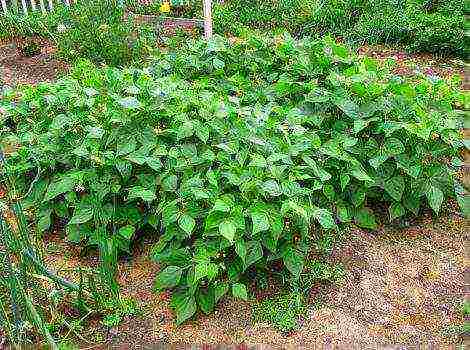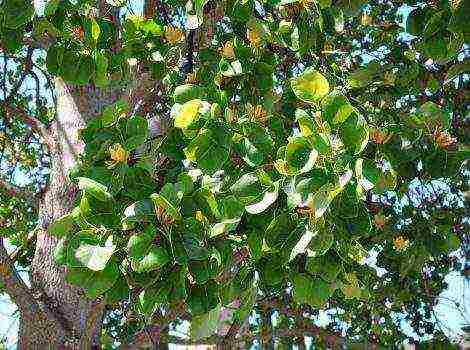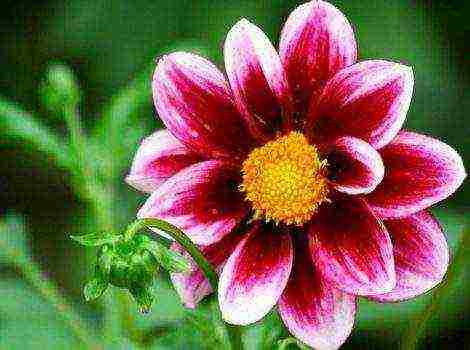Content
- 1 Features of growing watermelons in the Moscow region
- 2 Watermelon beds
- 3 Growing seedlings
- 4 Planting watermelon seedlings in a greenhouse
- 5 Vine formation
- 6 Pollination
- 7 Features of growing watermelons in the open field
- 8 Prevention of watermelon diseases
- 9 How to feed watermelons
- 10 What varieties are suitable
- 11 Planting dates for seedlings
- 12 Features of seedling care
- 13 Transplant to open ground
- 14 Follow-up care
- 15 Culture formation rules
- 16 When to harvest
- 17 Video "How to grow watermelons in the suburbs"
- 18 The best varieties of watermelon for the Moscow region
- 19 Conditions for growing watermelons
- 20 Growing watermelon seedlings
- 21 Planting seeds
- 22 Watermelon care
- 23 Diseases and pests of watermelons
- 24 Collection and storage of the harvest of watermelon
In the Moscow region, watermelons grow both in the greenhouse and in the open field, but it is more realistic to get a crop in a greenhouse than in a garden bed. With any growing method, care must be taken to provide these sissies with warmth.
Features of growing watermelons in the Moscow region
To grow watermelons in a not very hot and rather short summer, you will have to comply with a number of conditions:
- plant only early and early ripening varieties;
- grow by seedling method;
- plant seedlings in high beds under a temporary shelter, in a greenhouse or greenhouse;
- fill the beds abundantly (preferably from autumn) with rotted organic matter;
- maintain a temperature not lower than +12 ° C for young plants.
Varieties and hybrids of watermelons for the Moscow region
In the Moscow region, you can grow large, weighing 6 kg or more, watermelons. The varieties considered in the article received excellent reviews from summer residents.
- Ogonyok is an old, proven variety of Kharkov selection. Round fruits weighing up to 2.5 kg with a dark green peel ripen annually in the open field. The fire is resistant to fusarium, but can be affected by powdery mildew. The bark is thin and fragile. The taste is good. Seeds are small, dark. It takes exactly three months from sowing to harvesting ripe watermelons.
- Suga baby - the name is translated as "sugar baby". Berries weighing 1 kilogram. The bark is thin, dark green with stripes. The pulp is dark red. The taste is excellent. Seeds are brown with specks, small.
- Vector is a new ultra-early ripening variety. The first fruits can be tasted on the 58th day after sowing. The weight of each watermelon is about 3 kg, some specimens reach 5 kg. The crust is thin. The taste is excellent. This variety, bred in Russia, was included in the State Register of Breeding Achievements in 2017.Variety Vector is considered the most delicious among early ripening varieties and hybrids. Stored up to 20 days.
- Photon is an early ripe large-fruited variety, fruit weight up to 6 kg. The usual striped coloring, original oval shape, good taste. The thickness of the bark is 1.4 cm. In central Russia, it is grown in seedlings. Resistant to disease.
- Present to the North F1 is the largest of the early ripening ones. Berry weight up to 10 kg. The rind is very thick, like all large-fruited watermelons. Ripens 80 days after germination. Weight in the Moscow region is about 5 kilograms. The hybrid is cold-resistant, the fruits ripen even in cool weather. In the conditions of central Russia, when sown for seedlings in late April or early May, watermelons will ripen in the second half of August.
- Charleston F1 near Moscow is a sweet, large-fruited hybrid of early ripening (75–85 days). It can grow both in the greenhouse and in the open field. Fruit weight from 2.5 to 7 kg. In a greenhouse, when grown on a trellis, the fruits are smaller, 2-3 kg.
- Pink champagne F1 - reviews of summer residents from the Moscow region about this variety are positive. Early ripe. More demanding for warmth than Present to the North F1 and Charleston F1 near Moscow. The bark is thick, the flesh is light pink, sweet. In the conditions of the Moscow region, only one fruit is tied on a plant, the weight of which reaches 7 kg on high beds filled with organic matter.
Photo gallery: suitable varieties and hybrids of watermelons for the Moscow region
Watermelon beds
Choosing a good landing site is half the battle. Watermelon loves space and cannot stand shading. It is necessary that the bushes are illuminated by the sun all day, to the extreme leaf. A small slope will do. The rows in this case are arranged in a horizontal plane, and not from top to bottom.
The beds for planting watermelons are prepared in the fall. The roots of the watermelon go 40 cm deep. If the loose, fertile layer is less, the bushes will not be able to develop normally. Therefore, on heavy clay soils, planting pits are made with a depth of 45-50 cm. Even before planting seedlings, well-decomposed humus mixed with sand is introduced into the holes: one or two shovels of humus and up to three liters of sand per plant. The amount is determined based on the state of the original soil - light or heavy.
In regions with a cool climate, watermelons are grown in high, warm beds. Ideally, biofuel is laid in a narrow trench, rows of holes are made along the trench on both sides. Distance between rows - 80 cm. In a row between plants - 1 m. Between the edges of the beds at least three meters.
Growing seedlings
All summer residents acquire seeds with a huge supply, three times more than necessary. Firstly, I want to try different varieties and hybrids, and secondly, there is no guarantee that the seeds will sprout. However, you will have to sow a very specific amount, 4–6 more than the holes prepared for seedlings. In the warmth, the seeds germinate in a week from the beginning of germination or earlier, and it is already clear how many seeds to soak for the second sowing.
When to sow watermelons
The instructions on the bags and experienced summer residents say that the seedlings should be 25-30 days old by the time of disembarkation. If planted in a greenhouse or greenhouse on biofuel, this period can be sustained. But for planting on a bed under a film, it is better to sow three weeks before the intended planting. If it is warm and sunny, three-week-old seedlings will pick up faster than monthly ones. In case of bad weather, the landing should be postponed for a week.
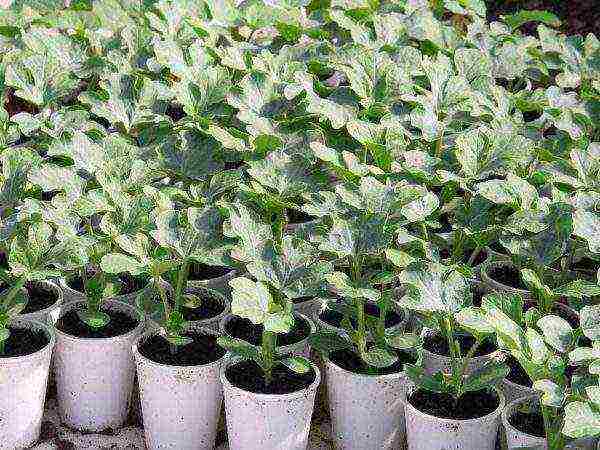
A month after sowing, the watermelon seedlings are ready for transplant.
How to help seeds germinate
The seeds can be processed by the producer, in which case they are sold in the form of granules, which do not need to be soaked, since the shell of the granules contains nutrients and protective substances. Seeds not in granules are soaked to accelerate germination.
- The seeds are soaked without treatment for a few seconds, after which they are washed.After that, the seeds of each variety are placed in bags made of thin cloth and immersed in hot water (50-60 ° C) for half an hour, then in cold water, but without chlorine. The ties on the bags are made in different colors and write down which variety.
- Fitosporin-M is diluted in a jar (15 drops per glass of water). The seeds are kept in this solution for 8–10 hours, then, together with the bags, are folded into a plastic bag and placed in the refrigerator for 12 hours.
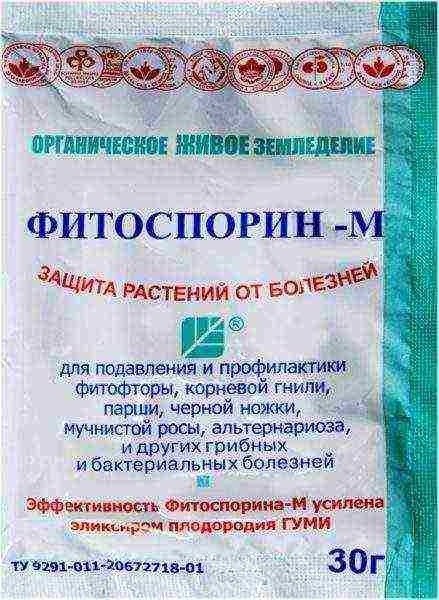
Soaking in Fitosporin-M solution is used to protect future plants from fungal and bacterial diseases
- After cooling, the bags with seeds are wrapped in a clean cloth and then placed in a plastic bag in a warm place until germination (for about two days). Be sure to unfold and ventilate every day and morning and evening.
Seeds need 24-28 ° C to germinate. Usually on the top shelf of the kitchen cabinet is the best place, but it is better to check with a thermometer.
Seeds are sown three days after soaking. You cannot put it off any longer, because the roots can be easily damaged on the germinated seeds.
Sowing watermelon seeds in cups
Cups for watermelons are taken with a volume of 0.5 liters, preferably plastic, not paper.
- A small incision is made at the top of the disposable "pot" to make it easier to remove the plants later. No drain is needed, but the holes in the bottom of the pot should be 1 cm in diameter, and not one, but three or four.
- Light soil is required: a mixture of leaf humus, compost and vermiculite (5: 5: 1). If there is no leaf humus, take peat or rotten sawdust.
- Watermelons stretch under artificial light. Therefore, the cups are filled with soil up to half the height. Then the soil is slightly compacted, the seeds are watered and laid out, sprinkled on top with a layer of 2 cm and again carefully compacted. And then a little, with a layer of only 2-3 ml, pour in washed, well-dried and heated sand.
- Until the emergence of shoots, the cups are kept in a warm place and not watered.
If there is not enough space on the windowsills, you can sow the soaked seeds into a common container and then dive them.
Video: how to plant watermelon seeds correctly
Seedling care
As soon as the first shoots appear, it is necessary to provide illumination for 12 hours a day. 10 days after sowing, the temperature at night is reduced to 18–20 ° C to prevent stretching of the sprouts.
The first feeding is done after the appearance of the second true leaf (the first leaves that appear above the ground are called cotyledons; then real leaves grow).
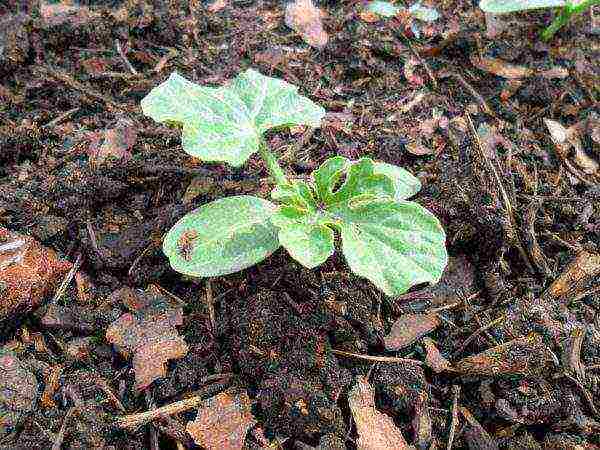
The first, oval leaves of a watermelon are cotyledonous, and those with cuttings are real
Liquid organomineral fertilizers designed for seedlings or indoor flowers are suitable. Fertilizer is applied at the root, it should not fall on the leaves. Two tablespoons of the nutrient solution is enough for the plant. After fertilization, you must immediately pour clean water.
A day after feeding, the seedlings are placed on the windowsill. It is important that small plants do not find themselves in a draft and do not fall under the stream of cold air from the window.
The second feeding is done 10-12 days after the first. For her, take a daily infusion of wood ash. For a liter of boiling water - 2 tablespoons without a slide. Stir, cover with a lid. After a day, carefully drained from the sediment and filtered.
Planting watermelon seedlings in a greenhouse
Watermelons can be planted in the greenhouse from the moment the soil in it warms up to 15 ° C (check with an ordinary street thermometer - put it on the surface of the earth). The beds covered with black foil or black spunbond will warm up faster.
Since the lashes of watermelons are long, the plants are tied to a trellis or net, like cucumbers. The trellis is installed before disembarking the seedlings. The vines are guided along the twine stretched from the bottom up between the trellis wires. We need to help the plants a little by twisting the main whip around the rope. The berries themselves are hung in nets as soon as the ovaries become the size of a large apple.The nets are attached to the trellis or greenhouse frame. It is necessary to take into account what the watermelon will be so that the mesh does not turn out to be tight and does not break.
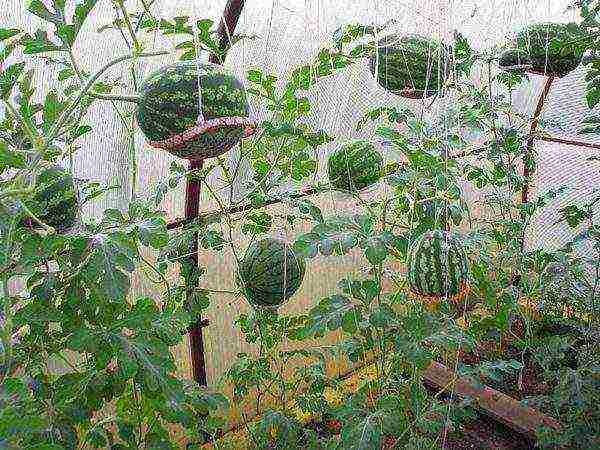
The fruits of watermelons have to be hung in nets so that they do not break off the stem due to their weight
Some gardeners use hemp made from scrap materials, for example, from plastic bottles, instead of a net.
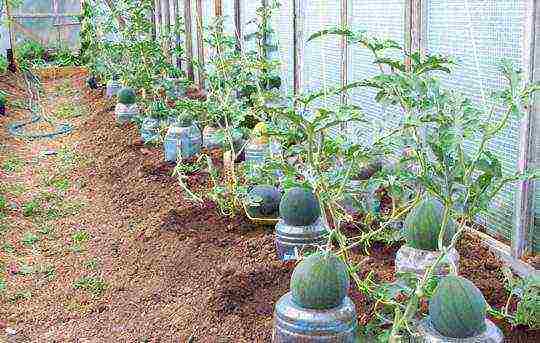
The original solution to place watermelons on stumps will save the fruits from being cut off from the bush.
The distance between rows in the greenhouse is 1 m, in a row - 50–70 cm, depending on the variety. For large-fruited hybrids grown in one stem, a 70 × 70 cm scheme is suitable. They are planted at the same depth as in a pot. The wells are watered with heated water (room temperature).
Saplings must be covered. From five-liter bottles with a cut-off bottom, they make mini-greenhouses for each bush, the lids are removed. In order not to cover each bush separately, you can set arcs with a height of 45-50 cm and stretch the spanbond. With its density of 25-30 g / m2, two layers are made, 42-60 g / m2 - one. You cannot use a film to cover watermelon plants in a greenhouse, under which the seedlings may die.
Video: planting grown watermelon seedlings in a greenhouse
Vine formation
In the greenhouse, excess leaves create excess moisture and impair the lighting of the plants. Only 5 leaves following it are left on the lash with the resulting watermelon. Not all ovaries are left, because the more fruits grow on the bush, the longer ripening lasts. The maximum possible load on a plant in a greenhouse is 10 kg. If the plant grows two watermelons weighing 8 kg, they will not even have time to turn red before the cold weather and sweets will not pick up. On one side shoot, you can leave no more than two fruits with a distance between watermelons on a whip of 5-6 leaves. If it is known that the fruits will weigh 3–3.5 kg, only 3 ovaries are left. On large-fruited varieties and hybrids (with fruits weighing more than 8 kg), two ovaries are left, but when the watermelons become larger than the walnut, the excess is cut off.

In order for the watermelons to ripen, excess shoots and leaves are removed
In hybrids, the fruits are tied on the main whip. The stepsons are removed. The top is pinched at a height of 1.8 m. In varietal watermelons, female flowers are formed mainly on the lateral shoots. Therefore, over the 7-9th leaf, you need to pinch off the top so that the watermelon begins to branch. The lowest 1–2 sprouts are removed from the leaf axils. When the fruits are tied, all excess shoots are cut out, and the fruiting ones are pinched 5 leaves after the ovary.
Pollination
Bees may not be able to cope with pollination of greenhouse watermelons. If the hive is not in or near the greenhouse itself, you will have to manually pollinate. It is not difficult, but the flowers do not bloom in one day, and you will have to replace the bee in several stages.
The female flowers already have tiny watermelons at the time of opening. You need to carefully pick or cut off the male flower, bend the petals and lightly touch the stamens of the female flower with the pistil. It is important that both flowers only open up, do not fade.
Pollination is finished when it becomes clear that each plant has the required number of ovaries.

A female flower grows immediately with a watermelon
Features of growing watermelons in the open field
For open ground, hybrid varieties of watermelons are well suited, since they are more resistant to diseases and sudden changes in temperature (Charleston F1 near Moscow, F1 Gift to the North). As for the ripening time, it makes sense to plant only early ripening varieties in open ground in the Moscow region. Then, even in a not too warm summer, watermelons will have time to grow and acquire the sugar content required for the variety. Seedlings are planted at the end of May at the age of 33–35 days. Seedlings should be with four true leaves.
- About a week before planting seedlings in the garden, they are hardened on a balcony, loggia or in a greenhouse. At the same time, the number of waterings is reduced.However, on the eve of transplantation, the seedlings are well shed and sprayed with a 1% solution of Bordeaux liquid to prevent fungal diseases.
- Seedlings are planted on warm beds prepared in autumn. After planting, watered once a week, and if the weather is very hot, then 2 times a week. After the appearance of female flowers, watering is carried out less often, and when the fruits are formed, they stop.
- Watermelons in the open field in the suburbs must be covered. After planting, they are grown under film or spunbond until the end of June. In July, the shelter is only left overnight if the nights are cold. At the same time, do not forget about airing so that condensation does not accumulate under the film or spunbond, since excessive moisture can lead to rotting of the watermelon fruits.
- Pollination of watermelons growing in open ground usually takes place without human intervention, with the help of insects. In order for bees and other pollinators to fly into the garden, plants with a smell attracting bees, for example, alyssum, are planted next to the garden bed.
Video: growing watermelons in the open field
Prevention of watermelon diseases
When planting for the prevention of diseases, it is recommended to water the wells with Fitosporin-M, diluted in the proportion of a tablespoon to a bucket of water, 0.5 liters per plant. When the temperature drops, the seedlings are additionally covered. The humidity in the greenhouse should not be high. Excess moisture and watering with cold water lead to root rot. The surface of the hole at the base of the bush is sprinkled with sand or sawdust.
How to feed watermelons
Two weeks after planting, you need a liquid fertilizing with organic matter (chicken droppings diluted in a ratio of 1:10 or green fertilizer - an infusion of grass fermented in the sun in a barrel of water for 3-5 days). Two more weeks later - complex fertilizer with microelements. The solution is poured only 0.5 liters per plant. The third feeding is done after setting the fruit with a daily infusion of ash (3 tablespoons of ash per liter of water), also 0.5 liters per plant. The soil must be mulched with sawdust or covering material with a high (up to 60 g / m2) density.
If you follow all the recommendations and in a good hot summer in the Moscow region, you can grow real sweet watermelons. Good luck, readers, and a good harvest!
Higher education. Married. There are no children yet.
Growing watermelons in the open field in the Moscow region is an attractive and interesting task for a gardener. It has long been no secret what the best varieties of watermelons will be for the Moscow region. Planting and caring for this useful and unpretentious crop will not be difficult even for an inexperienced gardener.
What varieties are suitable
It's no secret that the cultivation of watermelon is confined to areas with a milder, warmer climate than in the Moscow region. However, thanks to the efforts of breeders, today you can meet watermelons in the Moscow region in a greenhouse. Some plant seedlings of watermelon. For open ground, seeds of specially developed varieties are suitable.
The most famous among them were such varieties as "Skorik", "Ogonyok", "Lezheboka", "Charleston Gray", "Crimson Sweet" and "Pekinskaya Joy". This is not the whole list of varieties, the seeds of which are recommended to be used for seedlings in the Moscow region or planted directly in open ground.
Planting dates for seedlings
When to plant watermelon seedlings in this region? The timing of planting seedlings should be calculated according to the time when it will be possible not to be afraid of frost for these seedlings, which will be planted in the ground. Seedlings of a watermelon are ready for transplanting already on the 25-30th day of their development. Based on this, seeds should be sown no earlier than early April. Such planting dates are typical if you are going to plant seedlings in a greenhouse. Watermelons in the open ground in the Moscow region should be sown later - not earlier than April 25 to avoid frosts.
Features of seedling care
How to properly grow a watermelon in the suburbs in the open field? For this it is necessary to provide the seedlings with normal care. After the seeds are sown, they need warmth and plenty of moisture. Cover the container with plastic wrap and place in a warm place. On the fifth or sixth day, the seeds will hatch. During the period of the first leaves, plants need intensive feeding. For this, it is recommended to use bird droppings at a rate of 1 in 20.
After each watering, to protect the seedlings from diseases, the area around the seedling is sprinkled with ash.
It is important not to forget about the need to harden your watermelons. This process forms the resistance of plants to changing environmental conditions and helps them to take root. Move the plant pots from the shady side of the dwelling to the sunny one.
Transplant to open ground
Watermelon in the Moscow region has some peculiarities in cultivation. Transplanting grown seedlings into open ground is carried out at the time indicated above. You should focus on the beginning of June for crops that you will plant directly into the ground. Before planting in the ground, make sure that the soil for the plants is already prepared. It is necessary to dig up the ground well, carry out normal drainage.
Of the features of agricultural technology: plants are planted according to the scheme 1 to 0.7. For seedlings, holes are prepared with a depth of 15 centimeters, they are filled with water and the seedlings are already transplanted there. After planting, it is recommended to apply a layer of mulch to the ring around the post.
Follow-up care
The main task of the gardener is to keep the land around the watermelon weed-free in a loose, loose state. It is recommended to constantly loosen, weed, and, if possible, twist the plants to the state of cotyledon leaves. This will help your plants maintain a healthy root system.
Watering should be removed during the flowering and fruit setting phase. Get out of the calculation that it is one square meter of your culture you need at least four irrigations of 40 liters of water each, if outside the window is a dry year.
Watermelons need constant mulch changes. Top dressing is carried out twice a year. Mostly solutions of organic fertilizers are mullein (1 in 10), bird droppings (1 in 20) or fermented herbaceous tinctures.
Culture formation rules
In order to get large and juicy fruits, it is customary to make a culture pin in home melons. The first is carried out at a height of 5-6 true leaves. First, this is done with the apical bud in order to stimulate the growth of lateral shoots.
After a short time, you can pinch the growth points of the shoots, on which the fruits have already set. This will help reorient the plant's energy into the accumulation of nutrients in the fruit itself. For watermelons to be equally large and juicy, it is recommended to leave no more than three plants per bush.
In order for the pulp of your crop to gain weight equally, the ovary, when it is a little larger than a chicken egg, is set with the stalk up. This simple trick will help avoid uneven development of the watermelon.
When to harvest
The fruits are harvested approximately in mid or late August. Pay attention to the timing of the ripening of the culture and the time of its sowing. It is recommended to remove watermelons before the first frost, otherwise it can reduce the quality of their fruits. However, there is no need to rush into this - watermelons are not those plants that are capable of ripening on preservation.
Video "How to grow watermelons in the suburbs"
From this video you will learn how to properly grow watermelons in the Moscow region.
In the Moscow region gardens today, every summer resident is quite capable of growing a watermelon, and not only in a greenhouse, but also in the open field. However, it is easier to get a crop in greenhouse conditions than in the open air. Regardless of the chosen method of cultivation, the culture must be given attention and provide it with the necessary conditions for normal growth and development.
The best varieties of watermelon for the Moscow region
Although watermelon belongs to crops that prefer warmth, thanks to breeders it can be successfully grown even in the Moscow region, for which varieties with a short growing season were bred - early and medium-early. Therefore, it is worth dwelling on them in more detail.
For open ground
If your site does not have a greenhouse structure, then when choosing a watermelon, you must give preference to varieties that can be grown in unprotected soil in your region. Since summer in the Moscow region does not differ in its duration and hot weather, it is recommended to cultivate the selected varieties by seedlings.
Suga Baby
The ripening period of this variety is 65–70 days. The fruits are characterized by a round shape, a thin skin of a dark green color. The pulp is sweet with a granular structure. The berry is gaining weight up to 6 kg. This variety is adapted to different climatic conditions, therefore it can be used for cultivation not only in the greenhouse, but also in the open field.
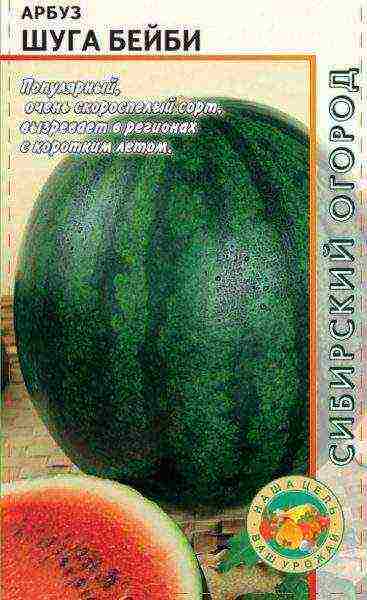 Suga Baby is an early ripening variety with a ripening period of 65–70 days and berries weighing up to 6 kg
Suga Baby is an early ripening variety with a ripening period of 65–70 days and berries weighing up to 6 kg
Maristo F1
This hybrid variety is characterized by early ripening within 58-60 days. A feature is resistance to diseases such as anthracnose and fusarium. Fruits gain weight up to 11 kg, have a dark green skin color with light sides. The flesh of the berry is quite dense, sugar-rich, has a rich color and a characteristic aroma. After harvest, the crop can be stored for a long time.
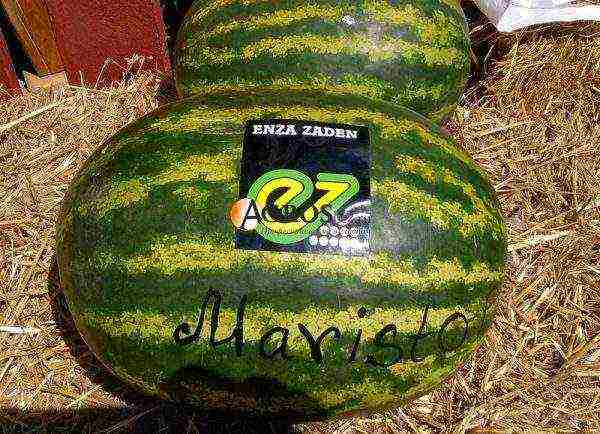 A feature of the Maristo F1 variety is resistance to fusarium and anthracnose
A feature of the Maristo F1 variety is resistance to fusarium and anthracnose
Baraka F1
An early hybrid that ripens in 72–77 days when sown outdoors and 60–64 days after transplanting. The fruits are oval in shape and weigh 11-13 kg. The pulp is dark red, sweet, has no fibers. The variety is resistant to fusarium and anthracnose. Has a long shelf life.
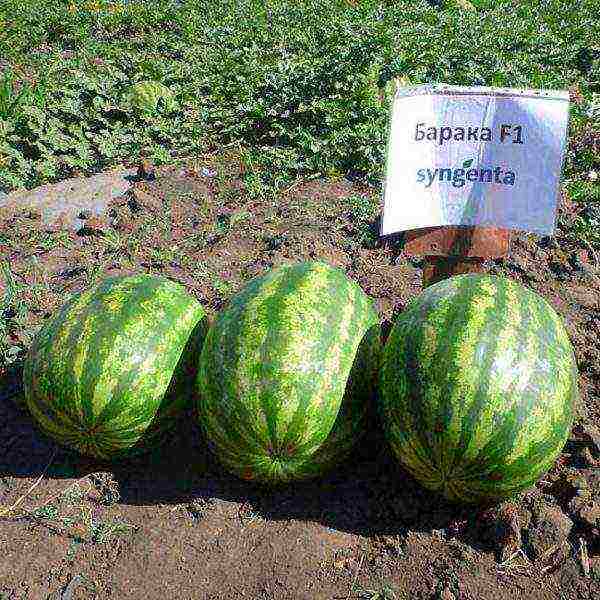 The Barak hybrid ripens in 72-77 days when sown in open ground and 60-64 days after planting seedlings
The Barak hybrid ripens in 72-77 days when sown in open ground and 60-64 days after planting seedlings
Fire
An early ripening variety that ripens in 85 days and is suitable for the conditions of the middle lane. Fruits gain weight up to 2.5 kg, have a thin dark green peel. The pulp is characterized by juiciness, aroma, sweetness, and has a bright red color. The variety is endowed with resistance to fusarium, but it can be affected by powdery mildew.
 Ogonyok is one of the popular early ripening varieties that is suitable for growing in the Moscow region.
Ogonyok is one of the popular early ripening varieties that is suitable for growing in the Moscow region.
Erken F1
A new ultra-early hybrid with a high yield that achieves the best performance when grown through seedlings. Refers to unpretentious varieties that require minimal maintenance. Fruiting is stable under different weather conditions. Fruits grow in weight 8-10 kg. The skin is light green with dark stripes. The pulp is dark red, crispy, sweet.
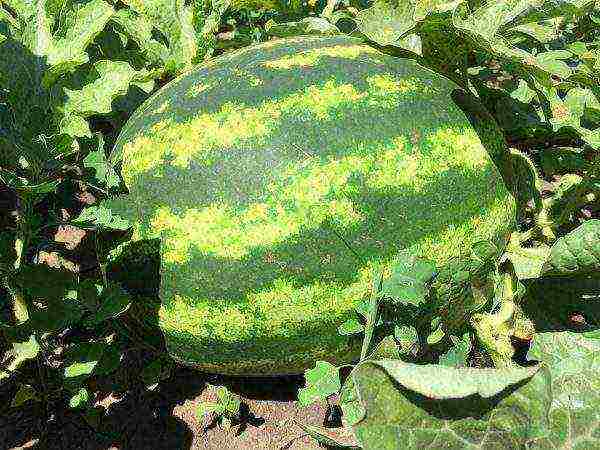 Erken F1 is an early variety that is endowed with a high yield with fruits weighing 8-10 kg
Erken F1 is an early variety that is endowed with a high yield with fruits weighing 8-10 kg
Anniversary
Mid-season hybrid, ripening in 95 days. It can be cultivated outdoors and in greenhouse conditions. The fruits are oval in shape, reaching a weight of 10 kg. The skin color consists of dark green and light stripes. The pulp is sugary, juicy, tender, with a rich scarlet color.
 Jubilee - a hybrid with a ripening period of 95 days, which can be grown outdoors and in a greenhouse
Jubilee - a hybrid with a ripening period of 95 days, which can be grown outdoors and in a greenhouse
For greenhouse
Growing watermelons in a greenhouse has its advantages, since it is easier for plants to provide the necessary conditions.
Honey
Ripening of this early-maturing variety begins 82-105 days after germination. The fruits have an elongated-rounded shape, reaching a weight of 3–6 kg. The peel of the berries is of medium thickness, green with darker stripes. The red pulp has an excellent taste, it is endowed with increased sugar content. The variety is moderately resistant to powdery mildew and other diseases of melons and gourds.
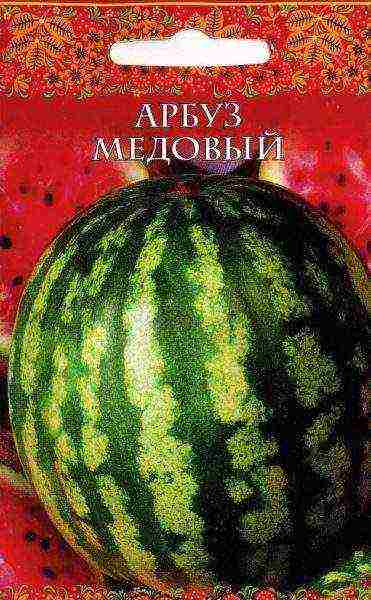 A watermelon of the Medovy variety ripens 82-105 days after germination, has elongated-rounded fruits weighing up to 6 kg
A watermelon of the Medovy variety ripens 82-105 days after germination, has elongated-rounded fruits weighing up to 6 kg
Skorik
An early ripening domestic variety that allows you to get a harvest in 65 days from the moment of germination. The fruits reach a weight of 3 kg, have a rounded-spherical shape, striped peel. The flesh of the berries is scarlet, juicy, dense, rich aroma. Fruit ripening occurs almost simultaneously. You can keep a watermelon in the refrigerator for several months.
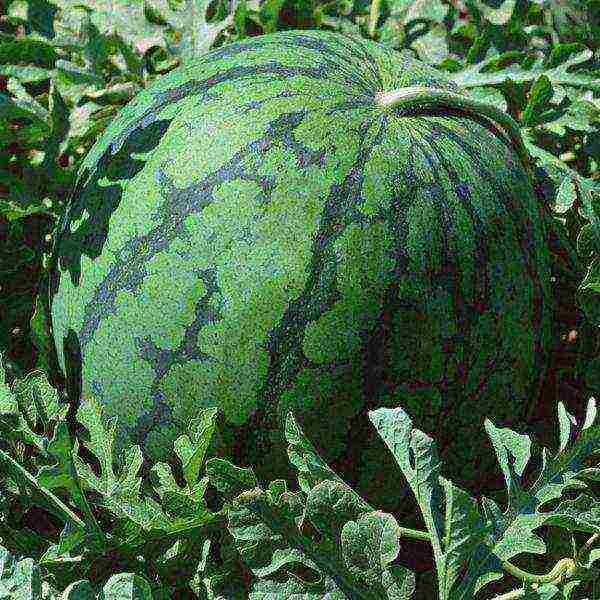 An early ripe variety with large fruits up to 3 kg, which ripen 65–90 days after germination
An early ripe variety with large fruits up to 3 kg, which ripen 65–90 days after germination
Crimson sweet
Medium early variety, ripening in 70–85 days. Fruits are round in shape with a smooth dark green skin with light stripes. The peel is smooth, dark green in color with light stripes. The average weight of the berries is 8–12 kg. The flesh of the fruit has practically no veins, it tastes scarlet, tender and honey. Watermelon has a long shelf life.
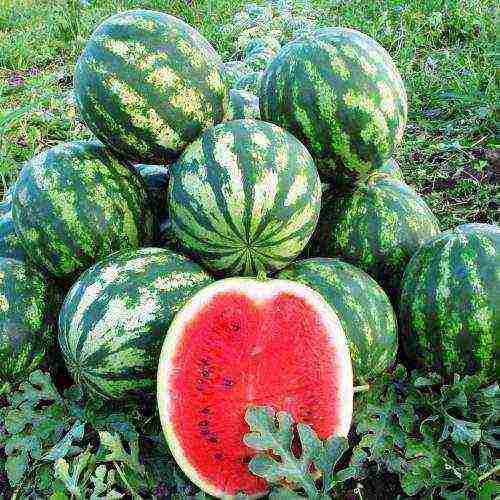 An early ripening variety with bright red and juicy flesh. Characterized by disease and pest resistance
An early ripening variety with bright red and juicy flesh. Characterized by disease and pest resistance
Krimstar F1
Super early ripening hybrid variety (56-60 days), suitable for open and closed ground. The fruit is characterized by a round shape, thin rind with dark stripes. The berry mass reaches 6–8 kg. The pulp is scarlet, juicy, tender, sweet. The variety is resistant to anthracnose, white rot, which makes it unpretentious to temperature changes.
 A super early variety with a ripening period of 56–60 days. Watermelon is resistant to anthracnose and white rot
A super early variety with a ripening period of 56–60 days. Watermelon is resistant to anthracnose and white rot
Conditions for growing watermelons
Since watermelon loves warmth, for its cultivation in the middle lane and northern regions, it is necessary to adhere to certain agrotechnical techniques. Seed material begins to germinate at + 15˚С, therefore, to obtain an earlier harvest, they resort to growing seedlings. To provide the plants with the necessary warmth in the early stages, warm beds can be organized, which are filled with organic matter.
As a result of the decomposition of the components of a warm bed, heat is released.
To smooth out the differences in day and night temperatures, bricks, stones, as well as water bottles are used, which play the role of heat accumulators: they are laid near the plants. When cultivating watermelons in greenhouse conditions, plants are formed in a vertical plane, and shelves, bags, etc., are used to support the fruits, which are tied to a trellis. In addition, at the initial stage of seedling development, the beds are additionally covered with foil. Now let's take a closer look at how to grow a watermelon by seedling and direct sowing of seeds into the ground.
Growing watermelon seedlings
Growing watermelon seedlings is not particularly difficult. The main thing is to prepare the seeds and soil and plant it correctly.
When to plant seedlings
Watermelon seedlings are planted in the ground at the age of 30 days. At this time, the plants should have 4 true leaves. Given that the seed material of this culture does not germinate very quickly, sowing should be carried out in mid or late April. It makes no sense to sow seeds at an earlier date.
How to sow seeds for seedlings
Growing healthy seedlings involves several stages, which consist in preparing the potting mix, seeds and planting containers.
Soil preparation
Properly prepared soil has a direct effect on the normal growth and development of young plants. For a watermelon, it is recommended to prepare a soil mixture according to the following recipe:
- 1 part of sod land;
- 3 parts of humus.
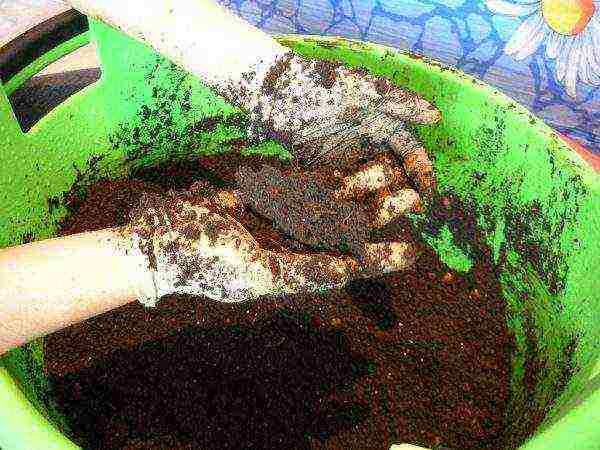 For growing watermelon seedlings, prepare soil from 1 part of sod land and 3 parts of humus
For growing watermelon seedlings, prepare soil from 1 part of sod land and 3 parts of humus
The components are mixed well before filling the containers. This recipe is not the only one and each gardener may have his own. You can also prepare this type of soil:
- 0.5 parts of humus;
- 1 part sawdust;
- 3 parts of lowland peat.
Preparation of containers
As a planting container for a watermelon, it is advisable to use separate pots, cups or cut plastic bottles.Thus, it will be possible to avoid damage to the roots when diving or transplanting plants into the ground. The optimal diameter of the container is about 10 cm.
 Sowing watermelon seeds can be done in any suitable container (cups, pots, cut bottles)
Sowing watermelon seeds can be done in any suitable container (cups, pots, cut bottles)
Seed preparation
The preparation of seed material allows not only to select high-quality seeds, but also to accelerate their germination, to carry out disinfection. To calibrate, seeds are poured onto a flat surface and sorted by size. This is done in order to land in different containers. Thus, stronger seedlings will not drown out the development of weaker seedlings.
Seedlings from small seeds will begin bearing fruit somewhat later.
One of the mandatory procedures that watermelon seeds are subjected to is warming up. This method improves the quality of the seeds and has a positive effect on the yield. To do this, they are heated in hot water (+ 50˚C) for 30 minutes. After the procedure, the seeds are placed in a solution of potassium permanganate (1%) for disinfection. Then they are dried in natural conditions and sown.
 Disinfection of planting material in potassium permanganate allows you to get rid of bacteria and fungal spores on the surface of the seeds
Disinfection of planting material in potassium permanganate allows you to get rid of bacteria and fungal spores on the surface of the seeds
To increase germination and shorten germination times, seeds can be germinated. In this case, after processing in manganese, they are wrapped in moistened gauze and placed in heat, where the temperature is maintained at about + 35˚С. During germination, you need to ensure that the tissue does not dry out and, as necessary, moisten it.
Planting seeds
After all the preparatory steps, you can plant watermelon seeds. This is done in the following sequence:
- Fill the container with soil, without adding 3 cm to the edges.
- A 3 cm depression is made and 2 seeds that have been hatched are lowered into it, covered with earth and spilled with warm water (+ 25˚C).
- Cover the containers with polyethylene and put them on the windowsill on the south side.
For normal seed germination, it is required to maintain the temperature at around + 25-27˚С.
Video: sowing watermelon seeds for seedlings
Seedling care
Seedlings appear in about a week. At this time, the film must be removed, and the temperature must be lowered to + 16-18˚С for 10 days. Then the seedlings are examined and the weakest shoots are removed, after which the temperature is raised to + 20-25˚С. At night, it is maintained at a level of + 18–20˚С. Such conditions must be maintained for three weeks.
Young seedlings need periodic watering, which is done with warm water. The soil should be saturated with moisture, but water should not be allowed to get on the leaves. After watering, the soil must be loosened. To avoid stretching the seedlings, it must be provided with enough light. To do this, you can use sodium, LED, phytolamps or fluorescent lamps. Daylight hours should be 12-14 hours. The room with seedlings must be regularly ventilated, but at the same time, drafts must be avoided.
Transplanting seedlings into the ground
One of the important stages before planting watermelon seedlings in the ground is hardening. They start it 7 days before the transplant of the seedlings to the site. For this, the temperature of the seedlings is gradually reduced (by 2–3˚) and watering is reduced. A few days before planting, the plants are well watered. In addition, spraying with a solution of Bordeaux liquid (1%) is performed. It is recommended to transplant seedlings in the morning, for which the sprouts are carefully removed from the container along with a lump of earth and transferred to the prepared hole. The planting hole is made so deep that the plants can be buried to the cotyledonous leaves. After planting, the plantings are watered and covered with foil.
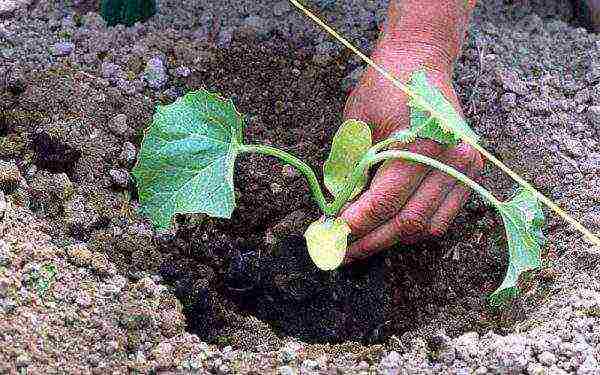 When planting, watermelon seedlings are buried to cotyledon leaves
When planting, watermelon seedlings are buried to cotyledon leaves
Planting seeds
The quality of the seeds directly affects their germination.Therefore, for planting, it is necessary to use only fresh seed, because small fruits are formed from the old. Regardless of whether it is supposed to be sown - in open ground or in a greenhouse, the seeds are prepared in the same way as for growing seedlings. Then they select and prepare a site for culture and sow.
In open ground
A well-lit area, closed from cold winds, is taken under the watermelon. It is best if before that crops such as potatoes, tomatoes, radishes, cabbage were grown on it. The soil itself is also important. This type of melon requires sandy or sandy loam soil fertilized with organic matter. It is best to start preparing the place in the fall. At this time, 1-2 buckets of humus and the same amount of sand per 1 m² are applied to a site with heavy clay soil, which will make the soil looser and lighter. You can also fertilize it with minerals. For this, 20 g of potash fertilizers, 30 g of ammonium sulfate and 40 g of superphosphate per 1 m² are applied. These elements will have a positive effect on the development of plants and will somewhat speed up the harvest.
When the site is prepared, you can start sowing, but you should pay attention to the timing. In the Moscow region, watermelon seeds are planted in open ground from late April to late June. More specific dates depend on the weather and the expected timing of the harvest.
To sow watermelon with seeds, the soil must warm up to at least + 16-17˚С.
Sowing is performed in the following sequence:
- Make a hole no more than 8 cm deep and spill it with water (1-2 l).
 For sowing a watermelon, make a hole 4–8 cm deep and spill it with water
For sowing a watermelon, make a hole 4–8 cm deep and spill it with water - When the water is absorbed, 3-5 seeds are placed in one hole with the flat side.
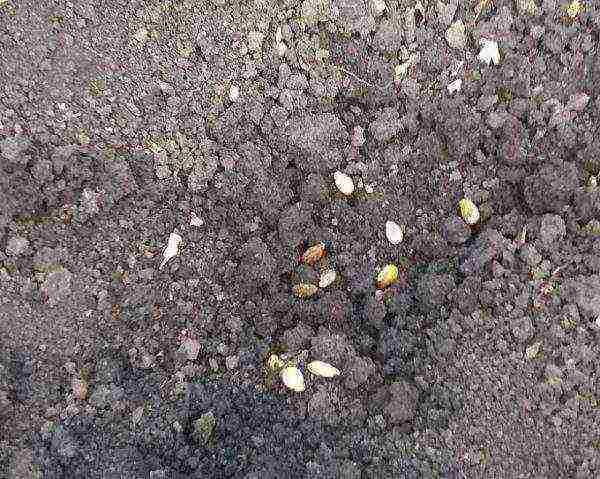 Several watermelon seeds are placed in the planting hole with the flat side
Several watermelon seeds are placed in the planting hole with the flat side - The seeds are sprinkled with earth, lightly tamped, but not watered, so that a soil crust does not form, which makes it difficult for seeds to germinate.
 After sowing the watermelon, the planting pit is covered with earth and lightly tamped
After sowing the watermelon, the planting pit is covered with earth and lightly tamped
Several seeds are planted in one hole in order to leave one most powerful seedling after germination, and remove the rest.
When planting a watermelon in open ground, a certain scheme is followed. The standard is the following: width between rows 2 m, between holes in a row 1 m.
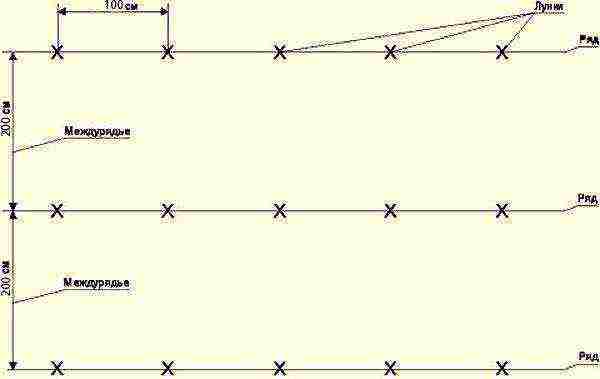 In open ground, watermelons are planted according to the following scheme: leave 2 m between rows, 1 m between holes in a row
In open ground, watermelons are planted according to the following scheme: leave 2 m between rows, 1 m between holes in a row
Video: sowing watermelon seeds in open ground
To the greenhouse
The greenhouse structure for the cultivation of watermelon can be film, glass or polycarbonate. The main condition that it must meet is a height of about 2 m. This is due to the fact that the watermelon weaves as it develops, and in closed ground it is formed vertically, tying it to a trellis. The structure should be located in an open area without any objects blocking the access of sunlight.
Attention must also be paid to the preparation of the greenhouse. First of all, the structure is checked for damage and malfunctions (film breaks, cracks, lighting problems, etc.). If any, repairs are carried out. In addition, it is necessary to process the greenhouse with copper sulfate (100 g per 10 liters of water).
 Before the new season, the greenhouse must be prepared, namely, washed and treated with copper sulfate
Before the new season, the greenhouse must be prepared, namely, washed and treated with copper sulfate
It is better to prepare the soil in the autumn. For this, beds are marked out with a width of about 1 m along the length of the structure. Grass, rotted manure with a layer of about 30 cm, and tops from the garden are laid as fertilizers. With the arrival of spring, humus can be added to the ground with the addition of mineral fertilizers. To improve the structure of the soil, it will be useful to add a bucket of river sand for 1 m² and dig up the soil. By the time the plants are planted, the ground should be warm enough.To do this, a week before planting, a layer of soil equal to the length of the shovel bayonet is removed, a mixture of humus and hay (straw) is laid, then spilled with hot water in large quantities. On top of such a pillow, put the previously removed earth. For better warming, the beds can be covered with a black film.
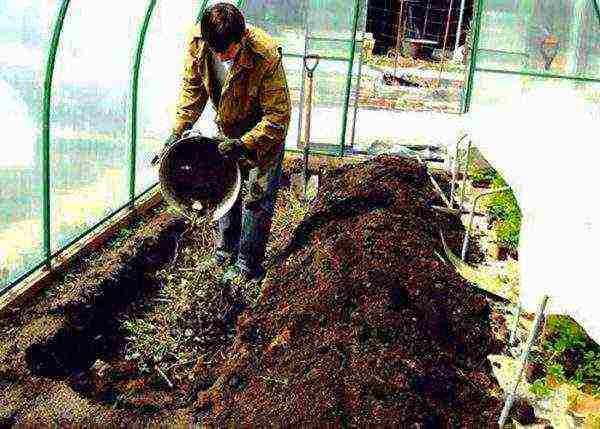 It is best to start preparing watermelon beds in a greenhouse in the fall and apply the necessary fertilizers
It is best to start preparing watermelon beds in a greenhouse in the fall and apply the necessary fertilizers
In the conditions of the Moscow region, watermelons are planted depending on when a stable temperature is established, since the soil must warm up to at least + 15˚С. For this region, the dates for planting crops in the greenhouse fall, as a rule, in April. If the structure is equipped with heating and additional lighting, then landing can be done a month earlier. For planting plants, shallow holes are made, in which two seedlings are placed: the seedling ball should be located 1 cm above the soil surface.To avoid damage to the roots, the shoots must be carefully removed from the planting containers.
Disembarkation can be done in different ways:
- On a bed with a width of 90 cm, a ridge is formed about 20 cm high and 50 cm wide. If the plants are planted in one row, then a distance of 50 cm is made between the holes. This planting method will be optimal for a small greenhouse.
- There is also a two-line method in which the seedlings are staggered with a distance of 70 cm between the holes.
Video: planting a watermelon in a greenhouse
Watermelon care
To get a good harvest of this melon crop, it is necessary to follow certain rules of care both in the open field and in the greenhouse.
In the open field
Caring for a crop is reduced to such agrotechnical techniques as watering, loosening, feeding, forming a bush.
Loosening
One of the conditions for obtaining a good harvest in the Moscow region is loose soil and the absence of weeds. For this, the earth is periodically loosened, weeds are removed, and the seedlings are spud up to cotyledon leaves.
It is especially important to loosen the soil after rainfall or watering so that there is no soil crust. Thus, the air flow to the roots is improved.
Watering
As for watering, they are done once a week, consuming 3 buckets of water per 1 m². In hot weather and during the flowering period, 2 such waterings are carried out per week, while the soil around the plants and between the rows is irrigated. After moistening the plant, it is recommended to mulch, which will retain moisture and prevent weed growth. As the fruit develops, watering is gradually reduced and completely stopped 2 weeks before harvest.
 Watermelons need to be watered once a week, spending 3 buckets of water per 1 m²
Watermelons need to be watered once a week, spending 3 buckets of water per 1 m²
Top dressing
During the growing season, watermelons are fed several times. With each feeding, one plant should have 2 liters of solution. A week after planting seedlings in open ground, it is watered with the following composition, which is prepared based on 10 liters of water:
- 40-50 g superphosphate;
- 30–35 g of ammonium sulfate;
- 15–20 g of potassium salt.
During the period of active growth of watermelon lashes, plants are fed with a similar solution, halving potassium and phosphorus fertilizers. Once again, the bushes are fertilized at the beginning of the formation of ovaries, for which a solution is prepared from the following components:
- 20-25 g of ammonium sulfate;
- 10 g superphosphate;
- 35 g of potassium salt.
The composition is introduced into pre-arranged furrows at a distance of 15–20 cm from the plants.
A lower content of nitrogen fertilizers during the last feeding will exclude the accumulation of nitrates in the pulp of berries.
Video: watering and feeding watermelons in the open field
Formation
To get larger fruits, watermelon bushes must be properly shaped. The procedure is pinching the shoots and is carried out as follows:
- The main stem is pinched after the formation of 5-6 true leaves. This will ensure the development of lateral shoots, on which ovaries will form.
- Pinch the growth points of the shoots on which the ovaries have formed. No more than three fruits are left on one bush.
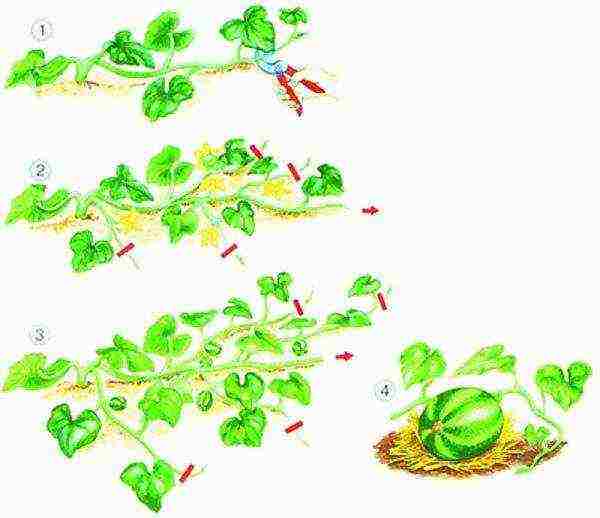 To get large and ripe fruits of a watermelon, it is necessary to correctly and timely form the bush
To get large and ripe fruits of a watermelon, it is necessary to correctly and timely form the bush
In the process of forming a bush, you need to monitor and promptly remove unnecessary stepsons. If the shoot has grown quite strong, then you do not need to pull it - it is better to cut it off.
The stepson is an escape that has formed from the leaf sinus.
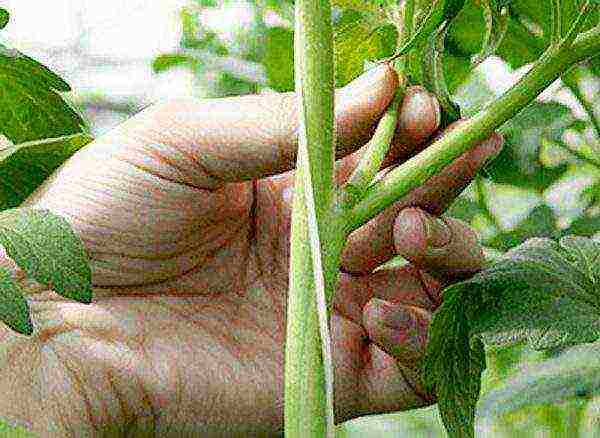 When forming a watermelon bush, it is necessary to remove stepchildren that develop from the leaf axils (in the photo, for example, a tomato bush)
When forming a watermelon bush, it is necessary to remove stepchildren that develop from the leaf axils (in the photo, for example, a tomato bush)
Video: the formation of a watermelon in the open field
In the greenhouse
In greenhouse conditions, it is not difficult to care for a watermelon, although some nuances must be taken into account.
Watering
At the beginning of summer, watermelons need watering, especially when hot weather sets in, the green mass grows, flowering and fruits are formed. Irrigation should be abundant, but not excessive, that is, water stagnation should be avoided. At the beginning of fruit setting, the number of watering is reduced to 1 time in 2 weeks. When an apple-sized fruit has formed, irrigation is stopped completely.
Excessive watering makes the watermelon less sweet, so it is hardly watered in July.
When irrigation is stopped, it is recommended to pour a layer of sand under the plant to better warm up the root system.
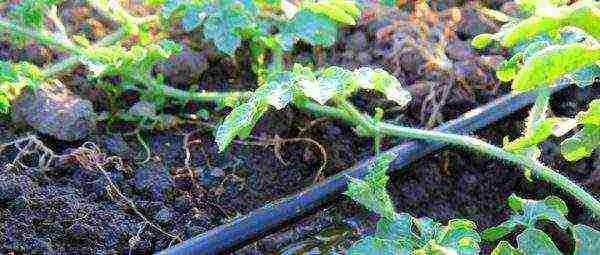 Most of all, watermelons need watering at the beginning of summer, during the growth of the green mass, flowering and fruit setting. The best option for these purposes would be drip irrigation.
Most of all, watermelons need watering at the beginning of summer, during the growth of the green mass, flowering and fruit setting. The best option for these purposes would be drip irrigation.
Top dressing
In the greenhouse, the watermelon is fed several times:
- when the length of the whip reaches 25 cm;
- before flowering;
- during the formation of the ovary.
It is best to use ammonium nitrate (20 g) diluted in water (10 l) as a fertilizer. In addition to mineral fertilizers, organic matter can be used, for example, chicken droppings. The nutrient solution is prepared in a ratio of 1:10 and applied under one plant, 0.5 l each.
 Watermelon is fed several times during the growing season, for which you can use both mineral and organic fertilizers, for example, a solution of chicken manure
Watermelon is fed several times during the growing season, for which you can use both mineral and organic fertilizers, for example, a solution of chicken manure
Temperature
Indoors, watermelon feels good at daytime temperatures of + 30˚C and night temperatures of + 20˚C. To prevent the formation of condensation, the greenhouse structure must be ventilated, while avoiding drafts.
Formation
Indoors, the melon crop under consideration also needs to be formed. The simplest option is to grow a watermelon in one stem. To do this, the main shoot is directed up the rope, and all the side ones are removed. Fruit setting takes place on the central stem. The main shoot is pinched, leaving 5 leaves after the top fruit. The amount of ovary that is left depends on the variety and the growing region. In the Moscow region, you should not leave more than three ovaries, since a larger number may simply not ripen. The number of berries that can be left is determined empirically.
 In a greenhouse, a watermelon is mainly formed into one stem, that is, when the fruits are formed only on the main shoot
In a greenhouse, a watermelon is mainly formed into one stem, that is, when the fruits are formed only on the main shoot
There is also a more complex way of forming a watermelon in greenhouses:
- The central shoot is fixed with a rope to the trellis.
- The bottom two stepsons are pinched at the beginning of development.
- Shoots on which female flowers have not formed up to 6-7 leaves are removed.
- Stems with female flowers, ie, with ovaries, pinch, departing 2-3 leaves from them.
- No more than three fruits are left on one plant.
- The main stem is pinched, departing from the upper berry 5 leaves.
With this method of formation, ovaries are formed on the lateral shoots.
Video: forming a watermelon in a greenhouse
Pollination
If there are no problems with pollination in the open field, then in the greenhouse it is recommended to perform this procedure on your own, since insects may not fly through the open vents and doors.To do this, the male flower is plucked, the petals are cut off from it, and it is leaned several times against the female flower (with anthers to the stigma). It is important that the temperature does not drop below + 12˚С, otherwise there will be no result from pollination.
Male flowers bloom first early in the morning and "live" literally for several hours, and female flowers - 2-3 days.
 Male and female flowers differ in appearance: the female is smaller in size and you can initially see a small ovary on it
Male and female flowers differ in appearance: the female is smaller in size and you can initially see a small ovary on it
Diseases and pests of watermelons
Watermelons, like many other garden crops, are susceptible to the negative effects of diseases and pests, and in order to take appropriate control measures, you need to be able to distinguish them.
Diseases
Sometimes gardeners pay most of their attention to the size and quantity of the ovary, and not to the state of the plant. As a result, the moments of infection of plantings with various diseases are missed, such as fusarium, anthracnose, root rot, etc.
Anthracnose
This fungal disease occurs with high humidity. It affects the aerial part of the plant, the stems become fragile. Infected fruits do not develop, their deformation and loss of taste are observed due to a decrease in sugars. Brownish specks appear on the surface of the watermelon, and ulcers appear on the stems. In wet weather, the lesions become covered with a pink coating. As a control measure, watermelon beds are weeded and diseased parts of the bush are removed. Bordeaux liquid (1%) is used for processing.
 Anthracnose appears as brown spots on the leaves and other parts of the plant.
Anthracnose appears as brown spots on the leaves and other parts of the plant.
Fusarium
When infected with this disease, the watermelon suffers and withers. Small leaves and fruits can be observed on damaged plants. As the disease progresses, darkening of the roots occurs, the stems rot at the base, the leaves turn yellow, and then dry and fall off. The disease occurs due to high soil moisture, low temperature (less than + 17˚C) or plant weakness. Therapeutic actions are carried out with the drugs Vitaros, Fitosporin, Trichodermin.
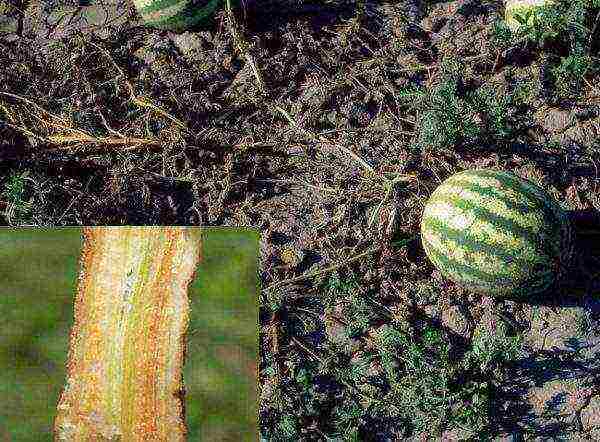 The disease manifests itself in the form of wilting and oppression of plants. The affected bushes are characterized by small leaves and fruits.
The disease manifests itself in the form of wilting and oppression of plants. The affected bushes are characterized by small leaves and fruits.
Root rot
The disease is caused by fungi that live in the soil. Favorable conditions for its development are temperature drops, humidity, improper care and excessive watering. The result is root thickening and cracking. Leaves on diseased plants turn yellow and gradually wither, which leads to the death of the bush. For prevention purposes, it is necessary to observe moderate watering using warm water. Every week, dust the root collar with activated charcoal or crushed chalk. In addition, it is recommended to spray the plantings with Fundazol (0.1%). If the plant is severely affected, it must be destroyed.
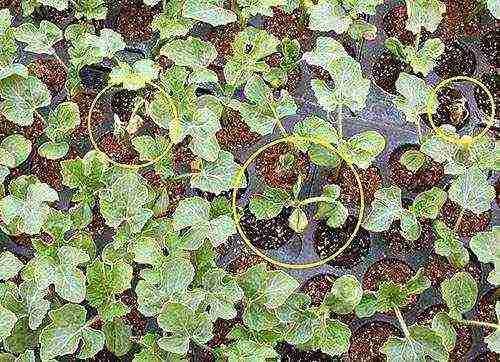 With root rot, the leaves turn yellow and wilt, which leads to the death of the plant
With root rot, the leaves turn yellow and wilt, which leads to the death of the plant
Powdery mildew
It is not difficult to reveal that the bush has contracted this type of fungal disease: spots appear on the leaves, tops of shoots and ovaries in the form of a white bloom. The fungus is carried over the site by precipitation, wind and direct contact between plants. If young bushes become infected, they simply die. The fruits are deformed, taste bad and often rot. It is necessary to fight the disease by removing the infected parts and processing with drugs such as Bayleton, Topaz, Tiovit Jet, Planriz.
 With powdery mildew, white, gray or pink bloom appears on the leaves of plants, after which wilting and drying of the foliage occurs
With powdery mildew, white, gray or pink bloom appears on the leaves of plants, after which wilting and drying of the foliage occurs
Pests
Some of the most dangerous pests of watermelons and other melons and gourds are wireworms, melon aphids, spider mites, sprout flies.
Melon aphid
The insect settles on plant stems in whole colonies, develops rather quickly. Harmful to melons, sucking juices from plantings, which leads to the death of flowers and ovaries. Favorable conditions for the development of the pest are humid and warm weather.The fight comes down to the regular removal of weeds and plant debris. In case of an aphid invasion, the following insecticides are used: Commander, Mospilan, Inta-Vir.
 It is impossible to overlook aphids on a watermelon, since the plant is sometimes covered with these insects.
It is impossible to overlook aphids on a watermelon, since the plant is sometimes covered with these insects.
Wireworm
Wireworms are the larvae of click beetles. They seriously damage the root system, as a result of which the plant dries out partially or completely. You can fight the pest by placing traps on the garden bed, which are jars filled with sliced beets, potatoes or carrots. Such traps are replaced with fresh ones 2-3 times a week. An extreme measure of control is the use of chemicals such as Provotox, Grom-2, Diazonin, but it is better to avoid the use of these chemicals because of their negative effect on both the soil and the crop.
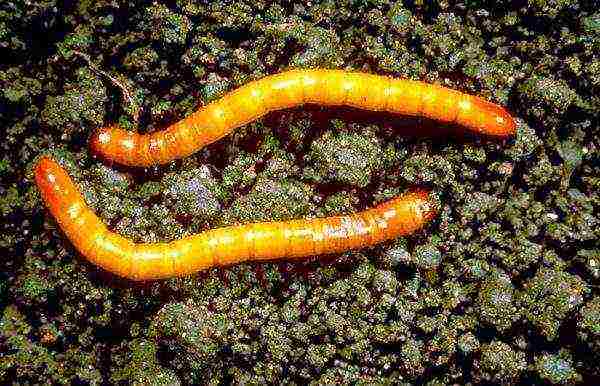 Wireworm damages the root system of the watermelon, which leads to partial or complete drying of the plant
Wireworm damages the root system of the watermelon, which leads to partial or complete drying of the plant
Spider mite
Signs of the appearance of a pest on a crop are numerous brown dots on the back of the leaf, which gradually increase in size. On flowers that did not have time to bloom, as well as on the ovaries and tops of the shoots, a cobweb forms. A plant affected by a tick turns yellow, dries up and dies. To combat the pest, acaricides are used (Apollo, Neoron, Aktofit, Aktellik).
 A spider mite can be found by the characteristic spider web on the back of the leaf.
A spider mite can be found by the characteristic spider web on the back of the leaf.
Sprout fly
The larvae of the sprout fly cause considerable harm to the melon. They penetrate through the germinated sprout, as a result of which the cotyledons are damaged and the seedlings rot. In order to prevent and destroy eggs wintering in the ground, they dig up the soil in the fall, and loosen it in the spring. For prophylaxis, it is recommended to soak the seeds in Fenturiam solution before sowing. In addition, a few days after planting the seedlings, spraying with Iskra Bio is carried out. If signs of a pest have been noticed, an insecticide similar to aphid control should be used.
 The larvae of the sprout fly damage both the seeds and the root system of plants.
The larvae of the sprout fly damage both the seeds and the root system of plants.
Collection and storage of the harvest of watermelon
For a watermelon to be tasty, it must ripen well, that is, be ripe. This can be determined by a drying stalk and a dull sound when tapping on the fruit. For the Moscow region, the optimal harvest time is mid-late August. In addition, if the watermelon is planned to be preserved, cleaning must be carried out with gloves, excluding damage to the surface of the berries. It is better to store later varieties for storage. With the right choice and the whole form, as well as creating favorable conditions, the berry can be stored for 1–5 months.
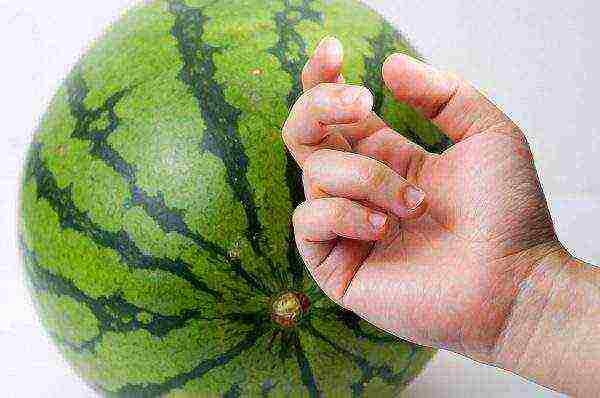 The ripeness of a watermelon is determined by a drying stalk and a dull sound when tapping on the fruit
The ripeness of a watermelon is determined by a drying stalk and a dull sound when tapping on the fruit
The storage location must meet the following requirements:
- constant temperature + 5–8˚С;
- humidity 60–80%;
- lack of lighting;
- air circulation.
In a private house, such a place can be a basement, an attic, a garage, a veranda. In apartment conditions, storage is possible on a glazed loggia, in a bathroom, a pantry.
Thinking about how to save a watermelon, you need to familiarize yourself with the possible ways:
- Hanging berries in nets with preliminary cloth wrapping.
- Covering the surface of the watermelon with paraffin or wax with a layer of 1 cm, which will prevent the formation of mold.
- Stacking the fruit with the tail down in a box with ash or dry sand.
- Separation of fruits from each other with straw. Thus, there will be no contact with a hard surface, which will exclude damage to the peel and will facilitate the absorption of excess moisture.
Video: how to store a watermelon
When choosing a suitable variety, observing the rules and agricultural techniques of cultivation, every gardener is quite capable of getting a harvest of watermelon in the Moscow region. At first, this task may seem daunting, but with experience the process will become simple and straightforward, and possible errors will be minimized.
Most gardeners say with confidence that it is impossible to grow watermelons in central Russia - the climate is not suitable. But some people do it. How to grow watermelons in the Moscow region, and then collect high-quality fruits, will be discussed in the article.
How to prepare a site?
Before growing watermelons in the Moscow region, you need to prepare the site. It has been harvested since November. The place should be level, as open as possible to sunlight. The soil is made slightly alkaline with a neutral pH and low groundwater level. It is advisable to build a fence from the wind from the northern part of the site so that the culture receives a lot of sun and is at least blown by cold winds.
In winter, the site is dug up and loosened. In early spring, in March, you can scatter ash over it (it will feed the soil and speed up the drainage of melt water). In April, the ground is watered with warm water and the areas where the seedlings will be planted with foil on pre-installed arcs or pegs are covered. The width and height of such a greenhouse should be small. This is done so that the earth warms up and does not lose moisture. At the same time, there will be much less weeds on such a site.
Thanks to this warming up of the soil, the question of how to grow a watermelon in the suburbs in the open field will cease to bother the gardener. Warm earth is a juicy and sweet fruit. But before covering the area with a film, it is advisable to fertilize it if it has not been fertilized for a long time. For 1 sq. M. 50 g of nitrophoska and 10 kg of rotted manure are taken.
How to grow seedlings?
The answer to the question - how to grow watermelons in the Moscow region, is simple - you must first make seedlings, and not plant seeds in open soil. Watermelon seeds do not take root really well in cool climates and, most likely, such a plant will not give the proper harvest. Therefore, before planting, they are germinated in pots on the windowsill, such as tomatoes. Seedlings of watermelons are much more likely to "survive" and produce high-quality fruits.
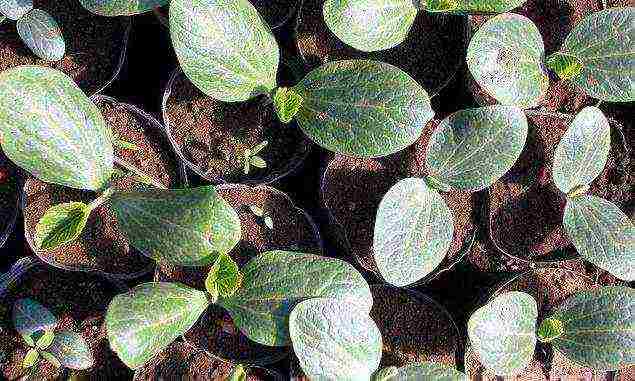 Growing seedlings of watermelons
Growing seedlings of watermelons
Not any type of watermelon is suitable for seedlings, only a few varieties take root in the Moscow region: Honey giant, Ogonyok, Early ripening sugar, Delicatessen F1, Farmer F1, Peasant, Peking joy F1.
Growing seedlings goes through several stages:
- Seed selection is necessary to remove the defective material. To do this, it is necessary to lower the seeds of watermelons into a solution of ordinary salt. All good seeds will settle to the bottom, and the floating ones can be thrown away.
- After selection, the seeds are soaked for several days in a dampened cloth or paper towel until sprouts appear. The fabric is placed in a plastic bag and placed in a warm place. The bag is opened daily for 30-60 minutes to ventilate the seeds.
- They are planted in half-liter pots with nutritious soil (peat, humus, turf and 1 tablespoon of complex fertilizer) at a shallow depth. 2 seeds sits in 1 pot and lightly watered. And in order for them to germinate faster, they are left warm and under the illumination of a fluorescent lamp.
- As soon as two leaves have appeared, one, the most tall, dense and bright sprout is left, and the second is removed or deposited.
When and how to plant seedlings outdoors?
For the survival of a watermelon in the open field, a soil temperature of up to 30 degrees above zero is required. Therefore, transplanting seedlings is postponed until the second half of June. By this time, the earth will warm up well under the film, it will become as acceptable as possible for the roots of the watermelon.
In June, seedlings are planted in open ground. For 1 square meter, no more than 2 seedling sprouts should be taken away. It is pointless to wait for the first month of strong growth. Melons initially develop the root system, and therefore are already growing. So a noticeable increase in shoots and flowers can be expected from mid-July. It is important to note that as soon as the first fruits become the size of a walnut, all excess shoots are pinched.
Many gardeners are wondering how to grow a watermelon in a greenhouse in the Moscow region? Here is about the same scheme. Plants are planted in a row at a distance of half a meter from each other, and they are pinched above 4 leaves. Follow-up care is the same as when planting in open soil.
 Watermelons in a greenhouse in nets
Watermelons in a greenhouse in nets
When the fruits of a watermelon reach a weight of 500-700 grams, they are placed in nets, which are tied to the arches or lintels of the greenhouse. Hanging watermelons in the greenhouse is necessary to prevent the fruit from breaking off under its own weight and prevents damage to the stems. The size of the net must be taken with a margin, periodically check the tension of the rope and make sure that the tail of the watermelon is not squeezed.
One trick can be attributed to the secret tricks on how to grow watermelons in the Moscow region outside the greenhouse and without warming the soil. To increase their resistance to winds and frosts, as well as temperature extremes, young shoots are grafted onto the same young pumpkin. Such a plant produces a harvest much faster. True, it will take skill for vaccination, but it is quite possible to carry out it.
How to care for watermelons?
From the moment of pinching, the plant needs special care.
- There should be as much sun as possible.
- To prevent the plant from drying out, it is watered abundantly 2 times a week with warm water.
- So that the stems and, mainly the fruit, do not start to rot, cardboard or wooden planks should be laid between them and the ground.
- From time to time, the culture is loosened, all the weeds are pulled out and complex fertilizer is applied.
When is the harvest?
The watermelon itself forms the size of the fruit and their number. Usually, no more than 5 full-fledged fruits ripen on one plant. If there are more of them, then the quality may suffer. They ripen from August to mid-September.
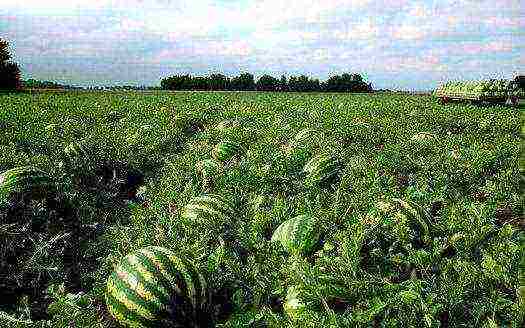 Watermelon field
Watermelon field
Two weeks before harvesting, watermelons stop watering and are covered in every possible way from the rain so that they are sweet and not watery. That's the whole science of how to grow a watermelon in the Moscow region in the open field or in a greenhouse. There is nothing complicated, only skill and patience are needed.
